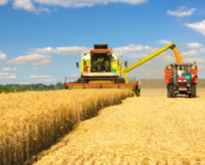In 2018, the harvested production of cereals (including rice) across the EU was 274.0 million tonnes. More common wheat and spelt was harvested than any other cereal (115.6 million tonnes; 42% of total EU cereals production). Common wheat and spelt accounted for a majority of all cereals production in almost one third of EU regions (67 out of 215 for which data are available).
Production was principally located in lowland regions characterised by large plains, a temperate climate and relatively modest levels of rainfall. The highest levels of harvested production generally ran in a band of regions from northern France, through Germany, extending into eastern regions of the EU along the floodplains of the Danube.
Source dataset: apro_cpshr
In 2018, the two regions with the highest levels of harvested production of common wheat and spelt were Centre — Val de Loire (4.4 million tonnes) and Picardie (4.3 million tonnes), both in France. Three other French regions — Champagne-Ardenne, Nord-Pas de Calais and Pays de la Loire — were also among the 10 EU regions with the highest levels of production.
The harvested production of common wheat and spelt was also relatively high in Castilla y León (north-west Spain) and Bayern (southern Germany), both these regions produced 3.6 million tonnes.
Would you like to know more about agricultural statistics at regional level?
You can find more information in the dedicated chapter of the new digital publication Regions in Europe, in the dedicated chapter of the Eurostat regional yearbook 2020 as well as in the corresponding maps in Statistical Atlas.
This news is published on the occasion of 'World Food Day' (16 October).
Notes:
- In this news item, the regional data are presented at NUTS 2 level with the exception of Germany (NUTS level 1).
- The European Union (EU) includes 27 EU Member States. The United Kingdom left the European Union on 31 January 2020. Further information is published here.
To contact us, please visit our User Support page.
For press queries, please contact our Media Support.

